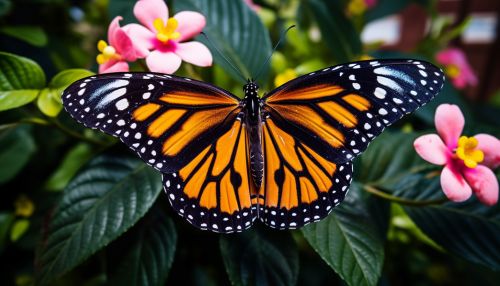Butterfly migration
Introduction
Butterfly migration refers to the regular seasonal movement of butterflies, particularly those species known as migratory butterflies. This phenomenon is primarily driven by seasonal changes and is characterized by the mass movement of butterflies from one region to another, often over long distances. The most famous example of butterfly migration is the journey of the monarch butterflies from the United States and Canada to Mexico and back.


Causes of Migration
The primary reason for butterfly migration is the change in seasons. Most butterflies are unable to survive cold winter temperatures, and thus migrate to warmer regions to avoid harsh weather conditions. Other factors influencing butterfly migration include food availability, mating habits, and population pressure. Some species, such as the painted lady, undertake migration for breeding purposes, moving to areas where their larval food plants are more abundant.
Migration Patterns
Butterfly migration patterns vary greatly depending on the species. Some butterflies, like the monarch, have a well-defined migration route and return to the same overwintering sites year after year. Others, like the painted lady, undertake a series of shorter, irregular migrations that do not follow a specific route or schedule. Some species, such as the red admiral, are known for their nomadic migration behavior, moving in response to changes in food availability rather than seasonal changes.
Butterflies use a variety of methods to navigate during migration, including the sun, the earth's magnetic field, and landmarks. Monarch butterflies, for example, are known to use a sun compass in their antennae to maintain their southern direction during fall migration. They also possess a time-compensated sun compass that allows them to adjust their flight direction as the sun moves across the sky. Other species, like the painted lady, use a combination of celestial and terrestrial cues to navigate during their migration.
Impact of Climate Change
Climate change is having a significant impact on butterfly migration. Rising temperatures, changes in precipitation patterns, and increased frequency of extreme weather events can disrupt migration patterns and affect butterfly survival. For instance, warmer temperatures may cause butterflies to start their migration earlier or extend their range further north. Changes in precipitation can affect the availability of nectar sources and larval food plants, which can impact butterfly reproduction and survival.
Conservation Efforts
Conservation efforts for migratory butterflies primarily focus on habitat preservation and restoration, particularly for overwintering sites and breeding grounds. For example, the Monarch Butterfly Biosphere Reserve in Mexico is a World Heritage Site that protects the wintering habitat of the monarch butterfly. Other conservation strategies include promoting sustainable agriculture practices, reducing pesticide use, and raising public awareness about the importance of butterflies and their habitats.
